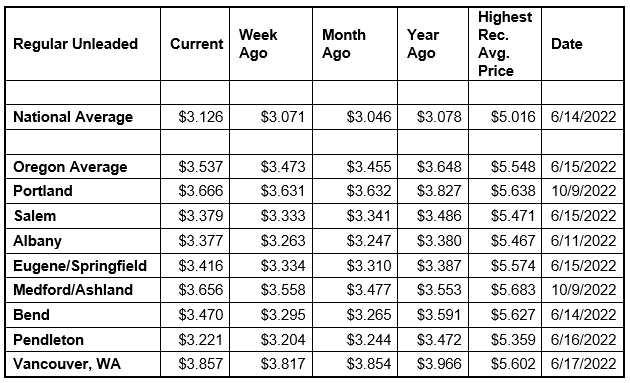
The price of crude oil jumped to $80 a barrel last week and that’s pushing pump prices higher in 45 states, including Oregon. Global oil prices have soared on concerns of tighter supplies as well as strong winter heating fuel demand. Investors are also keeping an eye on President Trump’s executive orders and the impact they could have on energy prices. For the week, the national average for regular rises six cents to $3.13 a gallon. The Oregon average also climbs six cents to $3.54 a gallon.

“The price of crude oil jumped to $80 per barrel, the highest price since last August, on news of reduced output from Russia and Saudi Arabia. And frigid winter weather is driving higher demand for heating oil. These increases in pump prices are coming ahead of the typical seasonal increases that happen when refinery maintenance season starts ahead of the switch to summer-blend fuel,” says Marie Dodds, public affairs director for AAA Oregon/Idaho.
The Oregon average began 2025 at $3.45 a gallon and is currently at $3.54. The average price of regular gas in Oregon in 2024 was $3.88, compared to $4.23 in 2023. The Oregon average began 2024 at $3.79 a gallon and ended the year at $3.45. The lowest price in 2024 was just under $3.45 a gallon on December 30 and the highest price of the year was nearly $4.51 on May 1.
The national average began 2025 at $3.06 a gallon and is currently at $3.13. The average price of gas nationwide in 2024 was $3.33, compared to $3.53 in 2023. The national average started 2024 at $3.11 and ended the year at $3.04. The lowest price in 2024 was $3.01 on December 10, and the highest was just under $3.68 on April 19.
Gas prices typically rise starting in mid-to-late winter and early spring as refineries undergo maintenance ahead of the switch to summer-blend fuel. The switch occurs first in California, which is why pump prices on the West Coast often rise before other parts of the country. The East Coast is the last major market to switch to summer-blend fuel. Most areas have a May 1 compliance date for refiners and terminals, while most gas stations have a June 1 deadline to switch to selling summer-blend until June 1. Switch-over dates are earlier in California with some areas in the state requiring summer-blend fuel by April 1. Some refineries will begin maintenance and the switchover in February.
Gas prices usually drop in the fall, due to the switch from summer-blend to winter-blend fuel, which costs less to produce. The switch starts in September. Many areas, including Oregon, can sell winter-blend fuel starting September 15. However, Northern and Southern California require summer-blend fuel through October 31. Prices usually decline to their lowest levels of the year in late fall and early winter before increasing again in the late winter and early spring.
Meanwhile, crude oil production in the U.S. remains near record highs. The U.S. Energy Information Administration (EIA) reports that crude production in this country slipped from 13.56 to 13.48 million barrels per day for the week ending January 10. The record high is 13.63 million barrels per day for the week of December 6. Production has been at 13.5 million barrels per day many times since October. The U.S. has been the top producer of crude oil in the world since 2018 and has been increasing its oil production since about 2009.
The U.S. price of crude oil (West Texas Intermediate) soared to $80.04 per barrel on January 15, which is the highest price since last August. Crude had been between about $67 and $74 per barrel from mid-October until January 10 when WTI closed above $76 per barrel.
Crude oil is trading around $77 today compared to $78 a week ago and $75 a year ago. In 2024, West Texas Intermediate ranged between $66 and $87 per barrel. In 2023, WTI ranged between $63 and $95 per barrel. WTI reached recent highs of $123.70 on March 8, 2022, shortly after the Russian invasion of Ukraine, and $122.11 per barrel on June 8, 2022. The all-time high for WTI crude oil is $147.27 in July 2008.
Crude prices are impacted by economic news as well as geopolitical events around the world including the unrest in the Middle East and the war between Russia and Ukraine. Russia is a top global oil producer, behind the U.S. and Saudi Arabia. Crude prices have been volatile after the attack on Israel by Hamas in October 2023. While Israel and the Palestinian territory are not oil producers, concerns remain that the conflict could spread in the Middle East, which could potentially impact crude production in other oil-producing nations in the region. In addition, production cuts by OPEC+ have tightened global crude oil supplies, which will continue to impact prices.
Crude oil is the main ingredient in gasoline and diesel, so pump prices are impacted by crude prices on the global markets. On average, about 56% of what we pay for in a gallon of gasoline is for the price of crude oil, 9% is refining, 19% distribution and marketing, and 17% are taxes, according to the U.S. Energy Information Administration.
Demand for gasoline in the U.S. fell from 8.48 million b/d last week to 8.32 million b/d for the week ending January 10, according to the U.S. Energy Information Administration (EIA). This compares to 8.27 million b/d a year ago. Meanwhile, total domestic gasoline rose from 237.7 million barrels to 243.6, while gasoline production popped last week, averaging 9.3 million barrels daily compared to 8.88 million barrels daily the previous week.
Pump prices will likely keep rising ahead of the larger seasonal increases that we normally see later in the season, especially if crude oil prices remain above $75 per barrel.
Quick stats
Oregon is one of 45 states and the District of Columbia with higher prices now than a week ago. Maryland (+23 cents) has the largest week-over-week increase in the nation. West Virginia (-3 cents) has the biggest week-over-week decrease.
Hawaii ($4.54) has the most expensive gas in the nation for the 12th week in a row. California ($4.45) is second. These are the only two states in the country with averages still at or above $4 a gallon. This week 23 states and the District of Columbia have averages in the $3-range. There are 25 states with an average in the $2 range this week.
The cheapest gas in the nation is in Mississippi ($2.63) and Texas ($2.71). No state has had an average below $2 a gallon since January 7, 2021, when Mississippi and Texas were below that threshold. At the time, the COVID-19 pandemic drove significant declines in crude oil and gasoline demand in the U.S. and around the world.
The difference between the most expensive and least expensive states is $1.86 this week, compared to $1.96 a week ago.
Oregon is one of 45 states and the District of Columbia with higher prices now than a month ago. The national average is eight cents more and the Oregon average is also eight cents more than a month ago. Delaware (+48 cents) has the largest month-over-month increase. Ohio (-6 cents) has the largest month-over-month drop in the nation.
Oregon is one of 16 states with lower prices now than a year ago. The national average is five cents more and the Oregon average is 11 cents less than a year ago. This is the third-largest year-over-year drop in the nation. Alaska (-23 cents) and Hawaii (-13 cents) have the largest yearly drops. Utah (+32 cents) has the largest year-over-year increase.














